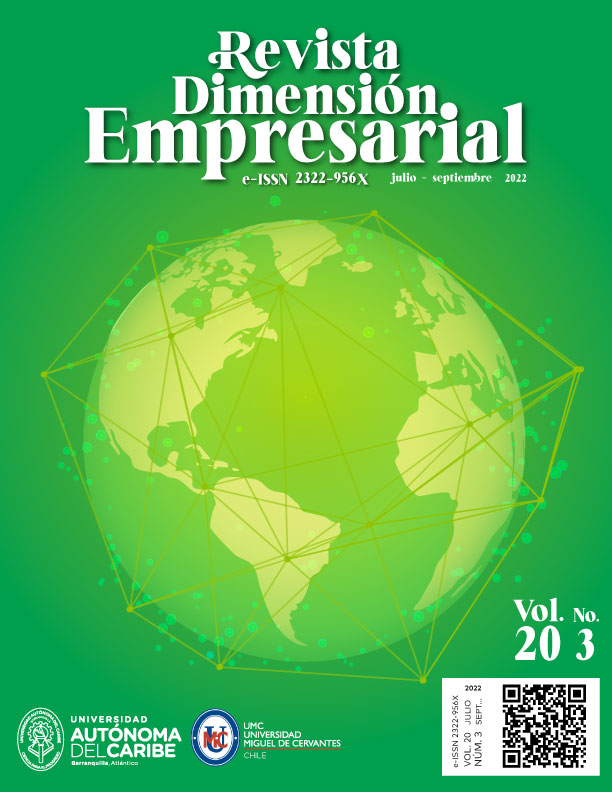Reintegración vertical de la Cadena de Valor en la industria de la movilidad eléctrica: innovación e inversión en componentes críticos, minería y geoestrategia
DOI:
https://doi.org/10.15665/dem.v20i3.3052Palabras clave:
Cadena de valor, Industria Automotriz, Vehículo Eléctrico, Minerales, BateríasResumen
El artículo analiza las implicaciones de la integración en la movilidad del vehículo electrificado y el consecuente impacto en la cadena de valor global. A través de la técnica de Sigue el Dinero se revela el cambio de tendencia de las cadenas de valor hacia la reintegración vertical de procesos de obtención de materias primas por parte de los fabricantes. En este contexto, las empresas vinculadas a la obtención de materias primas esenciales y reciclado de componentes se están posicionando en niveles superiores de la cadena de valor. Paralelamente, estas empresas están siendo objecto de compras por los principales fabricantes para retener el control sobre el abastecimiento de componentes, innovación tecnológica y poder de decisión. Los resultados obtenidos revelan la importancia del apoyo de los Gobiernos a las empresas asociadas a la minería sostenible, innovación y electrificación de los vehículos ya que constituyen un efecto tractor de industria y riqueza.
Citas
Ameen H. A., Mahamad, A. K., et al. (2019). A deep review and analysis of data exchange in vehicle-to-vehicle communications systems: coherent taxonomy, challenges, motivations, recommendations, substantial analysis and future directions, IEEE Access, 7, 158349-158378. https://doi.org/10.1109/ACCESS.2019.2949130.
Automotive New Europe (2022). EuroStellantis takes $52 million stake in sustainable lithium miner Vulcan Energy. Disponible en: https://europe.autonews.com/automakers/stellantis-takes-52-million-stake-sustainable-lithium-miner-vulcan-energy#:~:text=PARIS%20%2D%2D%20Stellantis%20has%20taken,with%20zero%20greenhouse%20gas%20emissions. (Acceso: 5 Agosto de 2022).
Berger, S. L. T., Tortorella, G. L., & Rodríguez, C. M. T. (2018). Lean supply chain management: a systematic literature review of practices, barriers and contextual factors inherent to its implementation. In: Davim, J. (Ed.), Progress in lean manufacturing. Management and industrial engineering, Springer: Cham. https://doi.org/10.1007/978-3-319-73648-8_2
Bonsu, Nana O. (2020). Towards a Circular and Low-Carbon Economy: Insights from the Transitioning to Electric Vehicles and Net Zero Economy. Journal of Cleaner Production, 256, 120659. https://doi.org/10.1016/j.jclepro.2020.120659
Desert Sun (2022). Electric vehicle maker Stellantis will buy lithium produced at Salton Sea. Disponible en: https://eu.desertsun.com/story/news/environment/2022/06/02/stellantis-buy-lithium-produced-salton-sea-controlled-thermal-resources/7483424001/ (Acceso: 5 Agosto de 2022).
EC, (2016). European Commission. A European Strategy for Low-Mission Mobility. Brussels. Disponible en: https://ec.europa.eu/clima/policies/transport_en. (Acceso: 5 Agosto de 2022).
EC, (2017). European Commission. List of Critical Raw Materials for the EU. Disponible en: https://ec.europa.eu/transparency/regdoc/rep/1/2017/EN/COM-2017-490-F1-EN-MAIN-PART-1.PDF. (Acceso: 5 Agosto de 2022).
EC, (2018). European Commission. European Innovation Partnership on Raw Materials: Raw Materials Scoreboard. Disponible en: https://publications.europa.eu/en/publication-detail/-/publication/117c8d9b-e3d3-11e8-b690-01aa75ed71a1. (Acceso: 5 Agosto de 2022).
Faro de Vigo (2022). Stellantis se alía con la viguesa Little para crear cargadores ultrarrápidos de baterías. Disponible en: https://www.farodevigo.es/economia/2022/07/22/stellantis-alia-viguesa-little-crear-68660605.html (Acceso: 5 Agosto de 2022).
France24 (2022). EU Parliament approves ban on new fossil-fuel cars from 2035. Disponible en: https://www.france24.com/en/europe/20220609-eu-parliament-approves-ban-on-new-fossil-fueled-cars-by-2035 (Acceso: 5 Agosto de 2022).
Frederick, S., (2014). Combining the Global Value Chain and global IO approaches. In Centre on Globalization, Governance & International Conference on the Measurement of International Trade and Economic Globalization Aguascalientes, Mexico (Vol. 29)
Frigant, V. & Layan, J.B. (2009). Modular production and the new division of labour within Europe: the perspective of French automotive parts suppliers, European Urban and Regional Studies, 16(1), 11-25.
Globisch, J., Plötz, P., Dütschke, E., & Wietschel, M. (2019). Consumer preferences for public charging infrastructure for electric vehicles. Transport Policy, 81, 54-63. https://doi.org/10.1016/j.tranpol.2019.05.017
Groh, A. P. (2010). The Capital Flow from Institutional Investors to Entrepreneurs. https://www.strategy-business.com/article/10217d (Accessed: 19 August 2022).
Herring, P., Balaji Gopal, C., Aykol, M., Montoya, J. H., Anapolsky, A., Attia, P. M., Gent, W., Hummelshøj, J. S., Hung, L., Kwon, H.-K., Moore, P., Schweigert, D., Severson, K. A., Suram, S., Yang, Z., Braatz, R. D., Storey, B. D. & Storey, B. D. (2020). BEEP: A python library for battery evaluation and early prediction. SoftwareX, 11, 100506. https://doi.org/10.1016/j.softx.2020.100506
Huang, Y., Han, W. & Macbeth, D. K. (2020). The complexity of collaboration in supply chain networks, Supply Chain Management, 25(3), 393-410. https://doi.org/10.1108/SCM-11-2018- 0382
Husain, I., (2010). Electric and Hybrid Vehicles: Design Fundamentals, 2nd ed.; CRC Press: Boca Raton, FL, USA.
Jürgens, U. & Krzywdzinski, M. (2009). Changing east-west division of labour in the European automotive industry, European Urban and Regional Studies, 16 (1), pp. 27-42
Karlan, D., Osman, A., & Zinman, J. (2016). Follow the money not the cash: Comparing methods for identifying consumption and investment responses to a liquidity shock. Journal of Development Economics, 121, 11–23. https://doi.org/10.1016/j.jdeveco.2015.10.009
Kchaou-Boujelben, M., & Gicquel, C. (2020). Locating electric vehicle charging stations under uncertain battery energy status and power consumption. Computers & Industrial Engineering, 149, 106752. https://doi.org/10.1016/j.cie.2020.106752
Kurzweil, P., & Garche, J. (2017). Overview of batteries for future automobiles. Lead-Acid Batteries for Future Automobiles, 27–96. https://doi.org/10.1016/b978-0-444-63700-0.00002-7
Lagadic, M., Verloes, A. & Louvet, N. (2019). Can carsharing services be profitable? A critical review of established and developing business models, Transport Policy, 77, 68-78. https://doi.org/10.1016/j.tranpol.2019.02.006
Lampón, J. F., Cabanelas, P. & Delgado-Guzmán, J. A. (2018). Keys in the evolution of Mexico within the global value chain in the automobile components industry: The case of Bajio, El Trimestre Económico, 85(3), 483-514. https://doi.org/10.20430/ete.v85i339.259.
Lampón, J. F., Lago-Peñas, S. & Cabanelas, P. (2016). Can the periphery achieve core? The Case of the automobile components industry in Spain, Papers in Regional Science, 95(3): 595-612. https://doi.org/10.1111/pirs.12146
Lampón, J.F., Lago-Penas, S. & González-Benito, J. (2015). International relocation and production geography in the European automobile components sector: the case of Spain, International Journal of Production Research, 53(5), 1409-1424
Masiero, G., Ogasavara, M. G., Jussani, A. C., and Risso, M. L., (2017). The global value chain of electric vehicles: a review of the Japanese, South Korean and Brazilian cases. Renewable and Sustainable Energy Reviews, 80, 290‐296.
McTaggart, N. A. (2017). Follow the money to achieve success: Achievable or aspirational. Journal of Financial Crime, 24(3), 425–436. https://doi.org/10.1108/jfc-03-2017-0022
Nelson, P., Santini, D. & Barnes, J., (2009). Factors determining the manufacturing costs of lithium-ion batteries for PHEVs. World Electric Vehicle Journal, 3(3), 457-468.
Nitta, N., Wu, F., Lee, J. T., & Yushin, G., (2015). Li-ion battery materials: present and future. Materials today, 18(5), 252-264.
Pavlínek, P. & Zenka, J. (2016). Value creation and value capture in the automotive industry: empirical evidence from Czechia, Environment and Planning A, 48(5), 937-959. https://doi.org/10.1177/0308518X15619934
Pelegrín, A. & García-Quevedo, J. (2012). Which firms are involved in foreign vertical integration?. Barcelona Institute of Economics (IEB), Working Paper 2012/38, Barcelona.
Ponte, S., Gereffi, G. & Raj-Reichert, G. (2019), Handbook on Global Value Chains, Edward Elgar Publishing, Cheltenham
Pütz, F., Murphy, F., Mullins, M., & O'Malley, L. (2019). Connected automated vehicles and insurance: Analysing future market-structure from a business ecosystem perspective, Technology in Society, 59, 101182. https://doi.org/10.1016/j.techsoc.2019.101182
Rodríguez-De La Fuente, M. & Lampón, J. F. (2020). Regional upgrading within the automobile industry global value chain: the role of the domestic firms and institutions, International Journal of Automotive Technology and Management, 40(3), 319-340. https://doi.org/10.1504/IJATM.2020.110409
Shah, S., Murali, M., & Gandhi, P. (2019). Platform software development for battery management system in electric vehicle. In 2019 IEEE international conference on sustainable energy technologies (ICSET). https://doi.org/10.1109/icsets.2019.8744886
Sonter, L.J., Dade, M.C., Watson, J.E.M. et al. (2020). Renewable energy production will exacerbate mining threats to biodiversity. Nature Communications, 11, 4174. https://doi.org/10.1038/s41467-020-17928-5
Sripad, S., & Viswanathan, V. (2017). Performance metrics required of next-generation batteries to make a practical electric semi truck. ACS Energy Letters, 2(7), 1669–1673. https://doi. org/10.1021/acsenergylett.7b00432
Sturgeon, T.J., Van Biesebroeck, J. & Gereffi, G. (2008). Value chains, networks and clusters: reframing the global automotive industry, Journal of Economic Geography, 8(3), 297-321. https://doi.org/10.1093/jeg/lbn007
Tracxn (2021). Global Startup Data Platform. Disponible en: https://tracxn.com/
Turienzo, J., Cabanelas, P., & Lampón, J. F. (2022). The Mobility Industry Trends Through the Lens of the Social Analysis: A Multi-Level Perspective Approach. Sage Open, 12(1). https://doi.org/10.1177/21582440211069145
Turienzo, J., Lampón, J. F. & Cabanelas, P., (2022c). El impacto del vehículo autónomo, conectado y compartido: de la industria automotriz tradicional a la cadena de valor de la nueva movilidad. Revista Dimensión Empresarial, 20(1), 1-21. DOI: https://doi.org/10.15665/dem.v20i1.2775
Turienzo, J., Lampón, J. F., Chico-Tato, R. & Cabanelas, P. (2022b). Electric Cars: The Future Technological Potential. In Parkhurst, G. & Clayton, W. (Eds.), Electrifying Mobility: Realising a Sustainable Future for the Car. Electrifying Mobility, 15, 191–209. Emerald Publishing Limited. https://doi.org/10.1108/S2044-994120220000015012
Turienzo, J. & Lampón, J. F. (2022). New mobility technologies as incentive to location decisions: relocation strategies in the automotive industry. Kybernetes, 51 (13) https://doi.org/10.1108/K-03-2022-0317
Turner, C., Di Tommaso, M. R., Pollio, C., & Chapple, K. (2020). Who will win the electric vehicle race? The role of place-based assets and policy. Local Economy, 35(4), 337–362. https://doi.org/10.1177/0269094220956826
Van Velzen, A., Annema, J. A., van de Kaa, G., & van Wee, B. (2019). Proposing a more comprehensive future total cost of ownership estimation framework for electric vehicles. Energy Policy, 129, 1034–1046. https://doi.org/10.1016/j.enpol.2019.02.071
Zhao, Z., Fan, X., Ding, J., Hu, W., Zhong, C., & Lu, J. (2019). The challenges in zinc electrodes for rechargeable alkaline zinc–air batteries: obstacles to commercialization. ACS Energy Letters. 4 (9), 2259–2270 https://doi.org/10.1021/acsenergylett.9b01541
Publicado
Cómo citar
Número
Sección
Licencia
Derechos de autor 2022 Javier Turienzo Riveiro

Esta obra está bajo una licencia internacional Creative Commons Atribución-NoComercial-SinDerivadas 4.0.
Tenga en cuenta que al presionar el botón "guardar y continuar" que está al final, Usted está asumiendo todos los compromisos éticos y legales que aquí se enuncian. Ellos establecen las responsabilidades de la legislación en materia de derechos de propiedad intelectual. Para esto se asume que quien está efectuando la acción de presentar el escrito obra de buena fe y se representa a sí mismo y a los demás autores del artículo postulado.
En este sentido, los autores conservan todos los derechos de los cuales son titulares y autorizan la reproducción gratuita del documento enviado. En el evento de ser necesario, asumirán, al presionar el botón "guardar y continuar", la responsabilidad legal derivada de los derechos patrimoniales los cuales son gratuitos en razón al no cobro por ningún procedimiento de la Revista.
En consecuencia, El(Los) autor(es) representados por quien adelanta la postulación del artículo a evaluación y eventual publicación,
Declaro(amos):
1. Que soy (somos) el (los) autor(es) del artículo {aquí va el nombre del artículo colocado automáticamente}.
2. Que ésta es una obra original conforme a la ley de propiedad intelectual de derechos de autor colombiana.
3. Que el contenido del artículo de la referencia no ha sido publicado y que no se presentará a ningún otro medio de publicación en soporte escrito o electrónico antes de conocer la decisión del Comité Editorial de Dimensión Empresarial.
4. Que el firmante de esta certificación garantiza que el compromiso que aquí adquiere no infringe ningún tipo derechos de terceros.
5. Que la autorización de publicación incluye su archivo electrónico y su adaptación, de ser necesario, para su incorporación en la red o en cualquier formato electrónico o base de datos, así como anexar los metadatos necesarios para realizar el registro de la obra, marcas de agua o cualquier otro sistema de seguridad o de protección.
6. Que la autorización de publicación incluye la reproducción en soportes digitales. Así como su distribución y la puesta a disposición a través de archivos institucionales a través de Internet, distribuir copias, y exhibirlo en Colombia y fuera del país, así como incluir el artículo en índices nacionales e internacionales.
7. Que el autor asume toda la responsabilidad, incluyendo las indemnizaciones por daños, que pudieran ejercitarse contra la Universidad Autónoma del Caribe por terceros que vieran infringidos sus derechos e intereses a causa de la cesión.
Por su parte, Dimensión Empresarial se obliga a respetar, en todo caso, los derechos del autor contenido en el artículo 30 de la Ley 23 de 1982, o cualquiera posterior a esta y pondrá el artículo a disposición de los usuarios de la Revista para que hagan un uso legítimo de él, según lo permitido por la legislación aplicable, siempre que se cite su autoría, no se obtenga beneficio comercial, y no se realicen obras derivadas.
Los autores/as se comprometen a aceptar las condiciones de esta nota de propiedad intelectual, que se aplicarán a este envío cuando sea publicado en esta revista (más abajo se pueden añadir comentarios al editor/a).




